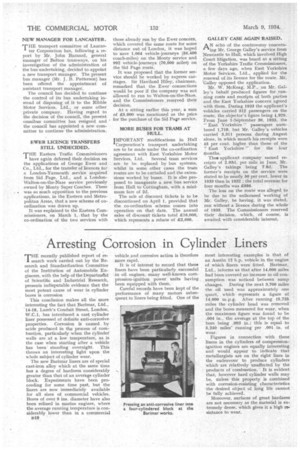Arresting Corrosion in Cylinder Liners T HE recently published report of
Page 132

If you've noticed an error in this article please click here to report it so we can fix it.
research work carried out by the Research and Standardization Committee of the Institution of Automobile Engineers, with the help of the Department of Scientific and Industrial Research, presents indisputable evidence that the most potent cause of wear in cylinder bores is corrosion This conclusion makes all the more interesting the fact that Barimar, Ltd., 14-18, Lamb's Conduit Street, London, W.C.1, has introduced a cast cylinder liner possessed of definite anti-corrosive properties. Corrosion is caused by acids produced in the process of combustion, particularly when the cylindei walls are at a low temperature, as is the case when starting after a vehicle has been standing overnight. This throws an interesting light upon the whole subject of cylinder wear.
The new Barimar liners are of special cast-iron alloy which at the same time has a degree of hardness considerably greater than that of an average cylinder block. Experiments have been proceeding for some time past, but the liners are now immediately available for all sizes of commercial vehicles. Bores of over 9 ins, diameter have also been relined in marine engines, where the average running temperature is considerably, lower than in a commercial
D10 vehicle and corrosive action is therefore more rapid.
It is of interest to record that these liners have been particularly successful in oil engines, many well-known compression-ignition power units having been equipped with them.
Careful records have been kept of the performance of many motors subsequent to liners being fitted. One of the
most interesting examples is that of an Austin 12 h.p. vehicle. in the engine of which liners were fitted. Barimar, Ltd., informs us that after 14,000 miles had been covered no increase in oil consumption was noticed between sump changes. During the next 3,700 miles the oil Used was approximately one quart, which represents a figure of 14,000 m.p:g. After running 15,725 miles the cylinder head was removed and the bores measured for wear, when the maximum figure was found to be .004 in., the average at the top of the bore being .003 in.; this is equal to 5,240 miles' running per .001 in. of wear.
Figures in connection with these liners in the cylinders of compressionignition engines are equally interesting and would appear to indicate that metallurgists are on the right lines in the endeavour to produce cylinders which are relatively unaffected by the products of combustion. It is evident that, however hard cylinder walls may be, Unless this property is combined with corrosion-resisting characteristics the desired object of long life 'cannot be fully achieved.
Moreover, surfaces of great hardness are not necessary as the material is extremely dense, which gives it a high resistance to wear.












































































































































































